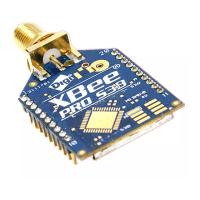Sleep modes Sleeping routers
XBee®-PRO 900HP/XSC RF Modules
60
1. Newer sleep parameters: the network considers a node using newer sleep parameters (SP and
ST) as higher priority to a node using older sleep parameters. See Change sleep parameters.
2. Preferred sleep coordinator: a node acting as a preferred sleep coordinator is higher priority to
other nodes.
3. Sleep support node: sleep support nodes are higher priority to cyclic sleep nodes. You can
modify this behavior using the SO parameter.
4. Serial number: If the previous factors do not resolve the priority, the network considers the
node with the higher serial number to be higher priority.
Commissioning Pushbutton option
Use the Commissioning Pushbutton to select a device to act as the sleep coordinator.
If you enable the Commissioning Pushbutton functionality, you can immediately select a device as a
sleep coordinator by pressing the Commissioning Pushbutton twice or by issuing the CB2 command.
The device you select in this manner is still subject to the resolution criteria process.
Only sleep coordinator nodes honor Commissioning Pushbutton nomination requests. A node
configured as a non-sleep coordinator ignores commissioning button nomination requests.
Change sleep parameters
Any sleep compatible node in the network that does not have the non-coordinator sleep option set
can make changes to the network’s sleep and wake times. If you change a node’s SP or ST to values
different from those that the network is using, the node becomes the sleep coordinator. The node
begins sending sync messages with the new sleep parameters at the beginning of the next wake
cycle.
n For normal operations, a device uses the sleep and wake parameters it gets from the sleep
sync message, not the ones specified in its SP and ST parameters. It does not update the SP
and ST parameters with the values of the sync message. Use the OSand OW commands to
query the operating network sleep and wake times currently being used by the node.
n Changing network parameters can cause a node to become a sleep coordinator and change
the sleep settings of the network. The following commands can cause this to occur: NH, NN,
and MR.
For most applications, we recommend configuring the NH, NN, and MR network parameters during
initial deployment only. The default values of NH and NN are optimized to work for most deployments.
Sleep guard times
To compensate for variations in the timekeeping hardware of the various devices in a sleeping router
network, the network allocates sleep guard times at the beginning and end of the wake period. The
size of the sleep guard time varies based on the sleep and wake times you select and the number of
sleep cycles that elapse since receiving the last sync message. The sleep guard time guarantees that
a destination module will be awake when the source device sends a transmission. As a node misses
more and more consecutive sync messages, the sleep guard time increases in duration and decreases
the available transmission time.

